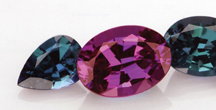Alexandrite
Alexandrite, a color changing gemstone, was first discovered in the
Ural mountains of Russia in the 1830's.
The finest material changes color from a ruby red to a emerald green. Most
gemstones show a more subdued color change or display less distinctive colors, typically a
greenish blue or yellowish green changing to a purplish red or pinkish red.
Alexandrite deposit have also been found in Sri Lanka and most recently in the
Brazilian state of Minas Gerais.
The gemstone is typically heavily included. Numerous inclusions are generally
observed under ten power magnification.
Large gemstones over 3 carats are rare. Due to its scarcity and
value Alexandrite is typically cut to retain weight. Well cut
gemstones are the exception
Alexandrite was named after Tsar
Alexander II since the very first crystals were discovered close to his twelfth birthday
in 1830 in emerald mines in the southern Urals region in Russia. It became the national stone of Tsar’s Russia
helped by the fact that the stone has a color change factor showing both red and green,
the main colors of the Russian flag at the time.
Top quality Alexandrite is very rare and rarely used in modern
jewelry. Rarer than fine ruby, sapphire or
emerald, the main attraction of Alexandrite is the breathtaking way it changes color
according to light. Green during the daylight,
the stone changes to a soft shade of red, purplish-red or purple-grey in candle light or
artificial light. Some have called it “an
emerald by day and a ruby by night”. Not
surprisingly, the more intensive the color change, the more valuable the stone. This feature makes fine Alexandrite, especially in
sizes of more than one carat, one of the most expensive of gemstones with interest in
stones of Russian origin the most sought after.
Interest in Alexandrite declined as Russian mines became exhausted
and other mine’s stones rarely showed the desired color change. Interest renewed somewhat when a mine in Hematita, Brazil
discovered Alexandrite with distinctive color change and good clarity. Although these Brazilian stones are beautiful with
arresting color change from raspberry red to bluish green, neither color has the intensity
of hue of the top quality Russian gemstones. There are other mining locations - Sri Lanka,
India, Myanmar, Tasmania and Zimbabwe - but today Hematita is one of the most important
sources in the world of Alexandrite.
Alexandrite and pearls are the birth stones for those born in June.
Because of its ancienticity, there is folklore aplenty connected with this incredible
gemstone. In important situations, Alexandrite is reputed to be able to strengthen its
wearer’s intuition to help him or her to find new solutions when logic fails to
provide an answer. It is also reputed to
support creativity and inspire imagination, balance in life and self esteem. According to legend, Alexandrite imparts the power
and ability to experience joy to its wearer.
Alexandrite is a sturdy stone that is excellent for every day wear
(8.5 on Mohs hardness scale). Because they are
so rare, there are many are many synthetic stones out there many complete with color
change. The largest cut Alexandrite weighs 66
carats and is displayed in the Smithsonian Institute in Washington, DC.
Alexandrite is so rare that anything over five carats is considered
exceptional. Post
